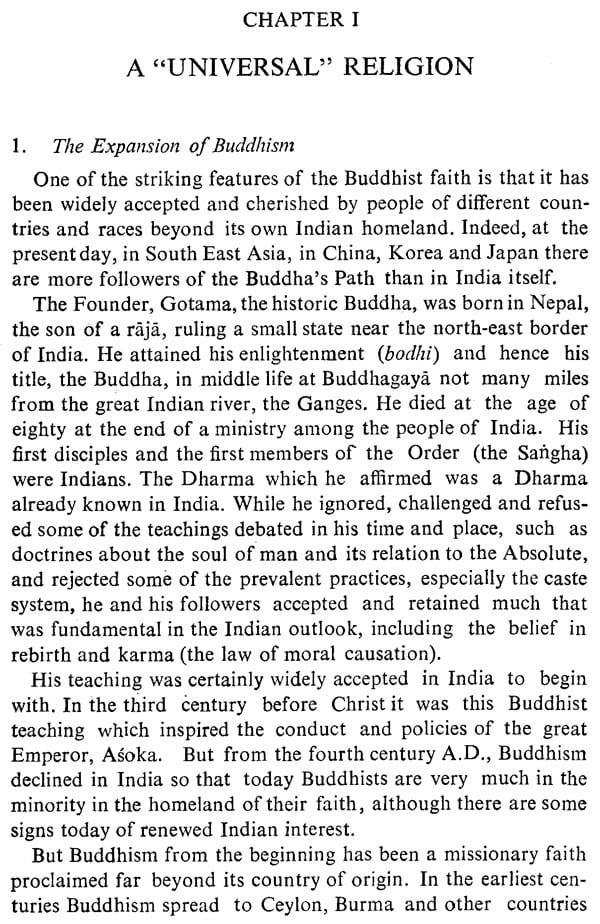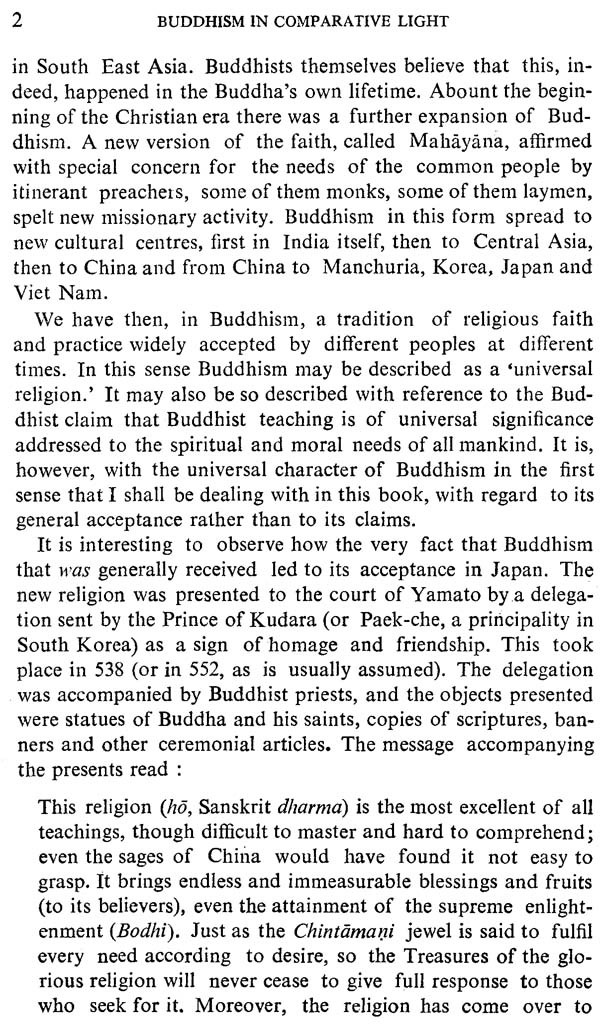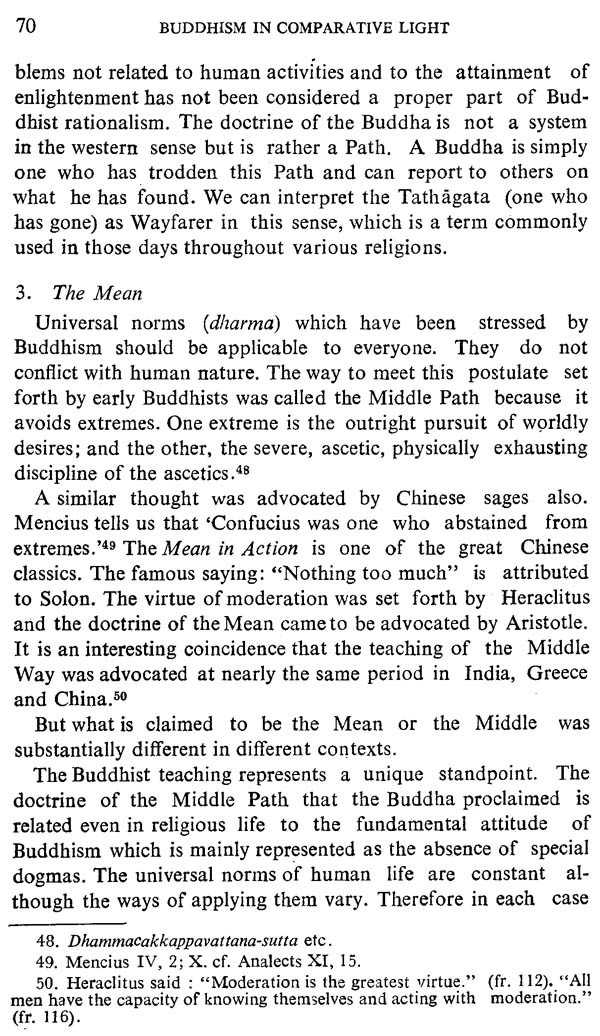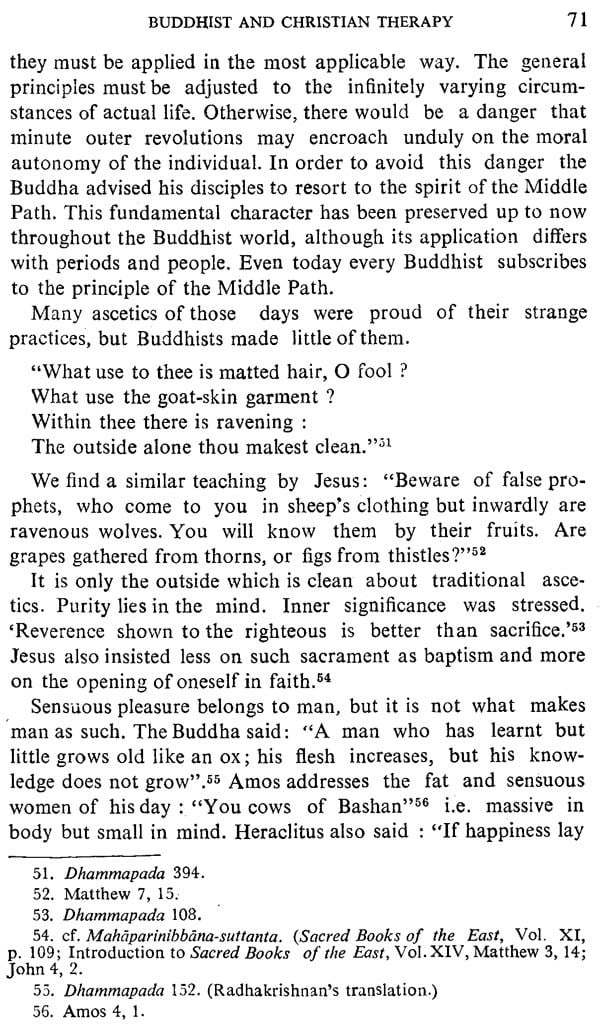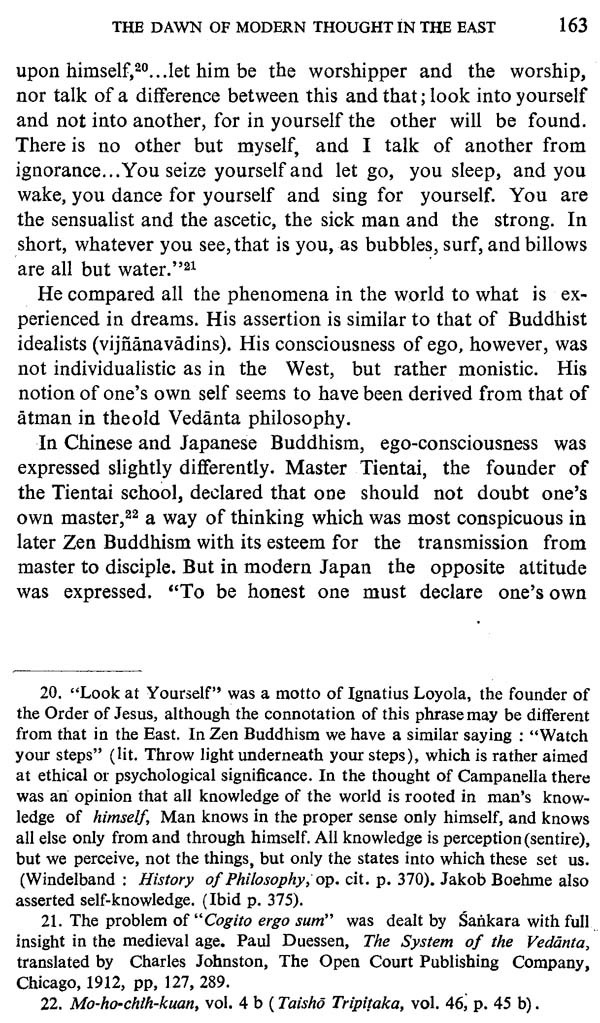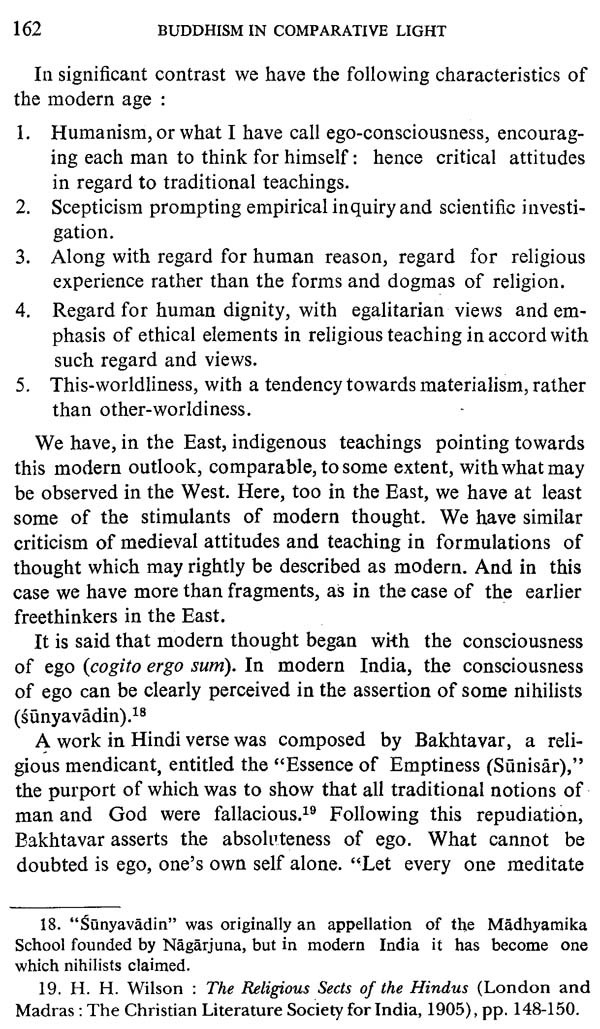
Buddhism In Comparative Light
Book Specification
| Item Code: | NAB930 |
| Author: | Hajime Nakamura |
| Publisher: | Motilal Banarsidass Publishers Pvt. Ltd |
| Edition: | 2010 |
| ISBN: | 9788120801844 |
| Pages: | 192 |
| Cover: | Hardcover |
| Other Details | 9.0 inch X 5.8 inch |
| Weight | 390 gm |
Book Description
This volume is comparative study of Buddhism and Christianity which despite their differences have striking similarities Chapters are devoted to probing religious consciousness far below the surface of dogma and traditions. Light is thrown on what Buddhism and Christianity and other religious and philosophical systems have meant to seekers of the truth of humanity. The treatment is selective and is concerned with the comparable features of major traditions shared by all great traditions of the world.
The volume is written from the stand point of a modern historian and thinker. It stands as a model for bringing out the common universalistic elements in various traditions as well as their special and distinctive features.
Hajime Nakamura (b.1912) is an academic and scholar of international repute. He obtained his D. Litt form the University of Tokyo and occupied the Professional chair of Indian and Buddhist philosophy at the same university for thirty years. He has been recipient of academic honors from several countries including India. He was a visiting Professor at Stand ford, Harvard, Hawaii and East West Centre In Honolulu.
Professor Nakamura is the Founder Director of the Eastern Institute, Inc. Tokyo; President of the Japan India Cultural Association; Member of the Japan Academy; Honorary Fellow of the Royal Asiatic Society of Great Britain and Ireland.
A versatile genius and a prolific writer his works include history of Vedanta (4 vols.) Early Buddhism (5 vols.), Japan and Indian Asia and History of the Development of Japanese thoughts (2 vols.). He was awarded the Imperial Prize by the Japanese Academy for his history of early Vedanta Philosophy and order of merit by the Emperor.
Professor Hajime Nakamura, respected throughout the world for his scholarly contributions to Indian and Buddhistic studies, has become known to an even wider circle of readers by his challenging book, Ways of thinking of eastern Peoples. In this book he pointed out the fact that, east of Suez as well as west of Suez, people in different countries have very much their own traditions and think and behave accordingly, a fact which is often ignored or obscured when contrasts are drawn, in broad general terms, between East and West. As part of his evidence, he referred to the history of Buddhism. For indeed we have here, as he observes, a "world religion whose basic principles are universal", transcending social and national distinctions, a religion accepted and welcomed by one people after another beyond its own Indian homeland. We have also a faith which as it passed from one Asian country to another, was in each case modified" according to the features peculiar to the ways of each recipient nation".
In this book, Professor Nakamura looks, as he puts it, at the other side of the coin. Here he is not so much concerned with the fact that Buddhism was thus modified as with the fact that it was widely accepted. How can we account for this response? Some may look no further than the evident zeal and devotion of the Buddhist missionaries. But Professor Nakamura probes more deeply. Asking what the Buddhist faith has meant to those who have sought to live by it, he suggests that it may be seen as a faith addressed to those fundamental problems which pertain to human existence, and, as such, presents answers to questions which all human beings may ask, regardless of race, nation or clime, concerning man’s condition, environment and destiny. But how can we discern these basic problems, or, in other words, determine what might be described as constituting the religious interest or what it is in man which may prompt him to "turn to religion?"
One plausible way of seeking an answer to such questions is to turn to some other world religion, with comparable claim to teachings of universal significance and a comparable history of widespread acceptance, considering to what extent it may be seen to present the human situation in much the same way as in the case of Buddhism. This is what Professor Nakamura does in these chapters. He turns to Christianity. He is not blind to the fact that in many respects Christianity and Buddhism are obviously deferent. Nevertheless he can, and does, claim that they have comparable histories, for, in Christianity, too, there is a history of missionary zeal followed by the expansion of the Christian faith beyond its homeland, a history of wide acceptance along with modifications as it is welcomed and received by different peoples in the West. This is his starting point. It leads him to examine other aspects of thought and life, doctrine and practice, in the two traditions which invite comparison insofar as they may be seen to be addressed to the same human problems. The answers given, he says in effect, may be different, but the questions dealt with are the same and there are also comparable responses.
Western readers—and he has such readers specially in view-will scarcely complain that Professor Nakamura has considerably more to say about Buddhism than about Christianity. He says modestly that he can expect them to be more familiar with their own tradition than he can claim to be himself. Nevertheless a good many readers may find his comments on Christian faith and practice written from a Buddhist standpoint, of particular interest. They are also written, it should be noted, from the standpoint of a historian of religions, and, as such, innocent of any attempt to evaluate and praise one faith at the expense of the other. At the same time, it may be held that the fact that Professor Nakamura is not only a distinguished Buddhistic scholar, but him self a devout Buddhist, enables a deeper under-standing of the Christian faith than would otherwise be the case. His treatment of the subject is avowedly selective, with principal regard for those aspects of faith and practice, Buddhist and Christian which may be held to constitute their universal appeal. This same aim also means however that in each case he looks down long corridors of history two thousand five hundred years in the one case two thousand years in the other. In regard to Buddhism this long view means a discussion of developments and tensions which is often illuminating. A good many western readers today may be specially interested in his presentation of the Pure Land teaching of other help or what is sometime is sometimes described as the Buddhist religion of grace as also in what he says in this respect regarding the tensions within Zen Buddhism.
Other may turn with particular interest to his last chapter in which he maintains that the east was not so unprepared for this modern age as in sometimes supposed all that is modern in the east today is not just western or entirely due to the impact of western civilization.
All told we have here a book which should be welcomed not only by those who had the privilege of meeting and hearing Prof. Nakamura when he was visiting Prof. at our Harvard Center for the Study of world Religions but by many readers elsewhere who did not have this privilege.
My aim in this book has been to view Buddhist history in a wider perspective and consider, in the light of comparative studies, some of the questions presented by this history.
My first word of thanks must be to my friends at the Center for the Study of World Religions, Harvard Divinity School. As a Visiting Professor at the Center from September 1963 to January 1964, I had an opportunity to complete a comprehensive survey of parallel religious developments, East and West, he present work is largely the outcome of that study there.
I am especially grateful to Professor Robert H. L. Slater, director of the Center at the time of my visit. He kindly edited my manuscript and reorganized it. I am also indebted to Dean Samuel H. Miller of the Harvard Divinity School, who, to my deep regret, passed away before the publication of this book, Professor Daniel H. H. Ingalls, Department of Sanskrit and Indian Studies, Professor Craig, Professor Krister Stendhal, Divinity School, Professor Robert Bellah, Department of Sociology, and other Harvard professors who kindly gave me much help and advice. I must also express my thanks to the present director of the Center, Professor Wilfred Cantwell Smith, for his interest in this publication, and to Professor Jeifrey Mason, who was then a graduate student in my seminar at the Center, and who helped me to express myself in English.
It is my hope that this work, although small in size, will stimulate discussion and further investigation, of the issues presented.
| Foreword | v | |
| Preface | ix | |
| I | A Universal Religion | 1 |
| 1. The Expansion of Buddhism | 1 | |
| 2. The Ministry motif | 5 | |
| 3. Comparable Histories: Buddhist and Christian | 9 | |
| II | The Buddhist way and the Christian way | 13 |
| 1. Way of Faith | 13 | |
| 2. Faith and Reason | 19 | |
| 3. The Limitations of Reason | 27 | |
| III | Diagnosis of the Human Condition | 35 |
| 1. All is Suffering All is Transient | 35 | |
| 2. Transmigration | 40 | |
| 3. Buddhist An Atta Doctrine | 46 | |
| IV | Buddhist and Christian Therapy | 53 |
| 1. The Goal | 53 | |
| 2. The Path to the Goal | 63 | |
| 3. The Mean | 70 | |
| V | The Monastic Order | 73 |
| 1. Striving in the path | 73 | |
| 2. Monastic Discipline | 77 | |
| 3. Buddhism and Society | 87 | |
| VI | Zen Buddhism | 107 |
| 1. Two Types of Religion | 107 | |
| 2. Buddhist Mysticism | 109 | |
| 3. Zen Meditation | 112 | |
| 4. Changes in the Monastic way of life | 123 | |
| VII | Pure land Buddhism | 132 |
| 1. The Compassion Motif | 132 | |
| 2. Human Corruption | 137 | |
| 3. Other Help | 144 | |
| 4. Conclusion | 151 | |
| VIII | The Dawn of Modern thought in the east | 153 |
| 1. East and western Civilization | 153 | |
| 2. Freethinkers in the East | 154 | |
| 3. Ego Consciousness | 161 | |
| 4. This worldliness | 166 | |
| 5. Conclusion | 175 | |
| Index | 177 |
